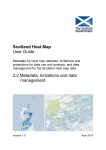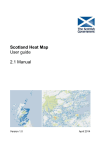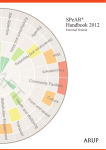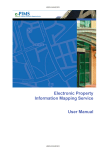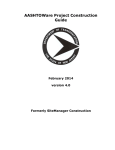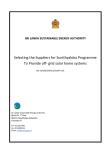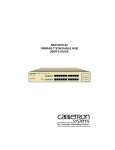Download Scotland Heat Map User guide 2.0 Methodology report
Transcript
Scotland Heat Map User guide 2.0 Methodology report Version 1.0 April 2014 Initial Methodology Report prepared by Carbon Trust Resources and Ramboll Energy for the Scottish Government. The Carbon Trust Forsyth House 93 George Street EDINBURGH EH2 3ES Scotland Ramboll Energy Hudson House 8 Albany Street EDINBURGH EH1 3QB Scotland Heat, Energy Efficiency and Low Carbon Investment Energy & Climate Change Directorate Scottish Government Victoria Quay Area 1 D South EDINBURGH EH6 6QQ e-mail: web: [email protected] www.scotland.gov.uk/heatmap © Crown Copyright 2014 Applications for reproduction of any part of this publication should be addressed to the above address. This report is published electronically to limit the use of paper, but photocopies will be provided on request to Building Standards Division. 2.0 Methodology report Revision Date Made by Checked by Approved by Description 1 25/04/14 Sophie Schorah/Paul Steen Paul Steen Paul Steen Report and Manual Ref. 61032638 Ramboll Hudson House 8 Albany Street Edinburgh EH1 3QB www.ramboll.com/energy 2.0 Methodology report Contents 1. 1.1 1.2 1.3 2. 2.1 2.2 2.3 2.4 2.4.1 2.4.2 2.4.3 2.4.4 3. 3.1 3.2 3.2.1 3.2.2 3.2.3 3.3 3.3.1 3.3.2 3.4 3.5 3.5.1 3.5.2 3.5.3 3.6 4. 4.1 4.1.1 4.1.2 4.1.3 4.1.4 4.1.5 4.1.6 4.1.7 4.1.8 4.1.9 Background Introduction and Objectives Policy Context Role of the Scotland Heat Map Methodology overview Project management Data management Software tools Methodology overview Data gathering Data processing GIS mapping Review and updates Heat Demand OS Mastermap and AddressBase Assessor and ePIMS Data Data Gathering Data Processing Future development projections Energy Performance Certificate (EPC) Data Gathering Data Processing Distilleries Actual energy demand (Public Sector) and procurement data Data gathering Data processing Database structuring Summary findings from heat demand layer Energy Supply and District Heating Networks Energy Supply Heat Network Partnership Local Authorities NHS Universities and Colleges 10 SEPA Energy Savings Trust Wastewater Treatment Sites Heat generation from Coal Authority 1 1 1 2 4 4 4 5 5 6 7 8 9 11 1 1 1 2 3 3 3 4 4 4 4 5 5 5 9 9 10 10 10 10 10 10 10 11 2.0 Methodology report 4.1.10 4.1.11 4.1.12 4.1.13 4.2 5. 5.1 5.1.1 5.2 5.2.1 5.3 5.4 5.5 5.6 6. 6.1 6.2 6.3 7. Heat generation from Forestry Commission Heat generation from Scotch Whisky Association (SWA) Heat generation from OfGEM Heat generation from WRAP District Heating Networks Other Layers Planning and Economic Development Future Heat Demand Tenure Data Gathering Opportunities and Constraints Layer Options Additional Information Utilities Layouts Disseminating the Heat Map Data Provided to Local Authorities Importing the heatmap to a local system Scotland heat map interactive Conclusions and Recommendations Appendix Appendix A Data Sources 11 11 11 11 11 13 13 13 14 14 14 15 15 15 16 16 16 17 18 2.0 Methodology report ABBREVIATIONS BER CC CL CT ECO EST GIS LA LDP HGPS HLA RE RES RO RHI SEPA SFHA SG SHCS SIMD SWA UPRN Building Emissions Rate Calculation Code Confidence Level Carbon Trust Energy Company Obligation Energy Savings Trust Geographical Information System Local Authority Local Development Plan Heat Generation Policy Statement Housing Land Allocations Ramboll Energy Resource Efficient Scotland Renewable Obligation Renewable Heat Incentive Scottish Environmental Protection Agency Scottish Federation of Housing Associations Scottish Government Scottish House Condition Survey Scottish Index of Multiple Deprivation Scotch Whisky Association Unique Property Reference Number 2.0 Methodology report 1. Background 1.1 Introduction and Objectives 1 This document is Scotland heat map – user guide 2.0 methodology report. It is part of a suite of user guide for the Scotland heat map. These can be downloaded from www.scotland.gov.uk/heatmap. 2.0 2.1 2.2 2.3 2.4 Methodology report Manual Metadata, limitations and data management Local knowledge validation & improvement process Scotland heat map – interactive and local web The objectives of the report are: to provide background on the purpose and possible uses of the Scotland Heat Map to outline the methodology of creating the Scotland Heat Map to describe in detail the calculations and data processing that were required for each layer This report comprises a review of the data received and the handling methodologies developed. It further sets out how the heat map is expected to be used and the database and Geographic Information Systems (GIS) tools that will be available. The report is intended to be a working document and stakeholders are invited to feedback through [email protected] or using form 2.3 local knowledge validation & improvement process. Scotland Heat Map user guide 2.1 manual for local authorities has been provided separately. This is part of a wider suite of documents to support use of the heat map. This document provides information on how to import and work with the Scotland Heat Map. In addition it provides the detailed calculations in the creation of the heat map to enable users to fully understand the layer packages and to enable users to replicate the calculations upon receipt of new data and updates. A full list of the heat map layer packages and metadata is presented in Scotland heat map user guide – 2.2 metadata, limitations and data management. 1.2 Policy Context Over 50% of the energy consumed in Scotland is used to heat and cool buildings and processes; in our homes, offices, hospitals, business and industry. The Scottish Government published its draft Heat Generation Policy Statement (HGPS) in 2014. It sets out how low carbon heat can reach more householders, business and communities and a clear framework for investment in the future of heat in Scotland. It highlights the key challenges of largely decarbonising our heat system; diversifying sources of heat and reducing reliance of fossil fuels; reducing the pressure on household energy bills, in particular for the fuel poor; and seizing the 2.0 Methodology report 2 economic opportunities that are presented from the transition to a low carbon heat system. The HGPS includes a number of existing and additional targets, such as: 11% of Scotland’s non-electrical heat demand being provided by renewable sources by 2020. An overall target of 1.5 TWh of heat to be delivered by district heating by 2020. The HGPS also proposes a target of 40,000 homes to be supplied with low cost, low carbon heat through heat networks and communal heating by 2020. 1.3 Role of the Scotland Heat Map Heat mapping is a powerful way to visualise and assess who needs heat, where sources of heat might come from and how these can be connected in an efficient way to reduce the cost of heat supply and the carbon intensity of heat generation. It can also be used, in combination with other spatial datasets as a tool to illustrate the socio-economic benefits of changing existing paradigms of heat supply. Each Scottish local authority (LA) has been offered the Heat Map dataset for their area to support local energy planning. The heat map dataset is very flexible and uses a Geographic Information System interface which allows analysis with other spatial datasets. The draft Scottish Planning Policy, published in April 2013, sets out that Local development plans should use heat mapping to assess the potential for co-locating developments with a high heat demand with sources of heat supply and that local development plans should support the development of heat networks. Scottish Government has issued advice (Scottish Government Planning and Heat ) on the role of planning authorities in the transition to efficient, low carbon and renewable heat. The heat map can support other policy areas such as reducing fuel poverty. The Scottish Government recognises that is a very real problem for far too many people in Scotland, putting at risk the very young and the elderly. Scotland is an energy rich nation but we currently only have control over one of the contributing factors to fuel poverty – the energy efficiency of Scottish dwellings. This advice describes how the heat map can support planning authorities and other policy area in developing policy, strategic development planning and determination stage. 1 The Scottish Government would like to thank all the contributors of data, many of which provided this in tight time frames. The Scotland heat map is a partnership project. Developing and maintaining the heat map relies on a wide range of data from Government, public and private sector bodies. This data has been drawn together to provide the highest quality map possible. All the data used in the heat map has been reviewed and classified as non-personal. A publically accessible heat map showing potential heat demand of settlements at an aggregated level will be available at www.scotland.gov.uk/heatmap in late spring 2014. The web tool is being delivered through a separate contract. 1 Scottish Government Planning and Heat online renewable planning advice (Scottish Government) http://www.scotland.gov.uk/Resource/0042/00422374.pdf 2.0 Methodology report 3 Three training sessions, held at the end of April 2014, supported local authorities to start to make use of the local heat data. The Scotland heat map builds on the pilot heat maps in Highland, Perth & Kinross and Fife. The approach to develop a national map was guided by discussions with local authorities. Local authorities recognised the value of a heat map, but also the challenge and resources required to collecting the data at a local level. They cited the benefits of collecting data at a national level, and providing a map that benefited both rural and urban areas. Carbon Trust Resources Ltd (CT) and Ramboll Energy (RE) were appointed by Resource Efficient Scotland on behalf of the Scottish Government to deliver a Scotland Heat Map. 2.0 Methodology report 2. 4 Methodology overview This section presents the overall methodology and approach to the heat mapping project. 2.1 Project management The Scottish Government and Resource Efficient Scotland led the development of the Scotland heat map. In order to support the project a core group was established with representatives from these organisations and additionally, Perth and Kinross Council (representing both local authorities and the Cities Alliance interest). Additionally a broader steering group was set up with wider representatives from these organisations and also from Heath Facilities Scotland. The steering group played a role in communicating the progress and importance of this project to the wider stakeholders. The quality and value of the heat map depends on the data used to generate it. Engagement with a significant number of public bodies that hold important data was vital so that the necessary level of detail and accuracy of data is provided. Key additional stakeholder input was sought for specific stages of the work, such as the Heat Network Partnership being consulted on potential uses of the heat map. Another important function of the steering group was to ensure that the heat map can be integrated with other analytical tools that the Scottish Government has developed. 2.2 Data management Due to the high number of records provided by a multitude of sources, a strict data management procedure is essential throughout construction and maintenance of the Scotland Heat Map. As each set of information is received it should be tracked through the data processing, database structuring and mapping process. Throughout this methodology report, field names are displayed in alternative font, for example FLOOR_AREA. Database titles will be presented in square brackets, for example [HEAT_DEMAND]. All organisations providing data to the heat map have been assigned a unique reference number. These are listed in Appendix A along with an indication of the data that was provided by each organisation. This reference number will be contained within a field entitled “ORG_NO”, which will enable the user to trace the origin of the data. Additionally the user will be able to filter the data by source and gain a clear picture of types of heat demand. In addition to the data sources listed in Scotland heat map user guide – 2.2 metadata, limitations and data management, various supplementary data sources are used in calculations to create the final heat demand figures. These include data sets such as national benchmark figures and degree days and these are also included in the user guide – 2.2. 2.0 Methodology report 5 The data provided for the heat map has varying conditions for use. Some is open data, some can be viewed publically but only shared at an aggregated level, and some is not available publically, but can be used for broader analysis such as statistical analysis and research. Guidance is provided in the Framework agreement and associated documents at www.scotland.gov.uk/heatmap. The heat map dataset is created from the most detailed sources of data available. However the complexity of developing a national dataset mean that there will be duplication and improvements needed. Local knowledge will be key to improving the quality of the dataset over time. There will be an initial validation and improvement period to the 31 August 2014 and then an on-going validation and improvement process outlined in Scotland heat map user guide – 2.3 Local knowledge, validation and improvement. On-going data management will be required. Local updates to data will need to be fed back to into the national map update process to ensure they are incorporated. This will require standardised data management processes and schema, including standard drop down menus. The approach is outlined in Scotland heat map user guide – 2.2 metadata, limitations and data management. 2.3 Software tools The heat map is produced using various software tools. Due to the very large amount of data received in the project, standard desktop software such as MS Excel and Access has not been adequate for processing and we have used MS SQL-server as the final collecting point for most of the calculated datasets. The following software has been used: ArcGIS desktop software with the extension “Spatial analyst”: All GIS handling and map production MS Excel and MS Access: For most of the initial data management, cleaning and merging of datasets besides calculation of benchmarks on selected datasets. MS SQL-server (SQL Express and SQL Server Professional) and Microsoft SQL Server Management Studio: For later data management, handling of large, merged datasets, address matching and final calculations of heat demands. 2.4 Methodology overview The heat mapping process involved a series of stages: 1. Data gathering 2. Data processing 3. Database structuring 4. GIS mapping 2.0 Methodology report 6 Figure 1: General illustration of the overall steps applied to data to prepare and include in the heat map 2.4.1 Data gathering Many organisations provided data. The data was not originally collected for the purpose of the heat map. This meant that some of the data had to be cleaned, addresses checked, and where possible Unique Property Reference Numbers Added. The key learning point is that for the public sector to be able to share data more fully in the future there should be a move to more standardised approaches to holding data. The Unique Property Reference Number, also known as the UPRN provides the best place to start. The organisations that hold relevant energy supply or demand data for the heat map are listed in the Scotland heat map user guide – 2.2 metadata, limitations and data management. During the data gathering phase of the project requests for information were sent out to the relevant organisations in addition to a template in which they could enter the data. Information requests that were sent out were tracked in a data checklist. A significant amount of effort was necessary on the part of the suppliers of data to gather information and the Scottish Government are grateful to them for taking the time to respond. It is worth noting that every local authority and non-departmental public body (NDPB) responded to the request for properties where they controlled energy billing data. The process of following up on requests for information required a significant resource that was provided by members of the core group. 2.0 Methodology report 7 A list of all organisations providing data and the content of data that was received is indicated in the Appendix A. The following key figures are identified from the data received: All 32 local authorities, the NHS and circa 30 Non-Departmental Public Bodies provided heat demand information in the form of accurate energy billing data on the properties. 5,000 records could be used in the heat map where the UPRN could be identified or matched to the addresses provided. 16 local authorities provided their planning data as GIS shape files. 21 local authorities provided records of cooling towers . All 14 assessors provided their property databases including a significant number of records that included UPRNs. Layout plans of 18 existing or proposed district heating networks were provided and mapped combined with point references from the HNP to identify a total of over 200 networks across Scotland. 2 It is noted that further information is available and can be included in the heat map in subsequent versions. Development of the heat map will be undertaken and data validation and improvements can be provided using Scotland heat map user guide – 2.3 Local knowledge, validation and improvement. The Scottish Government has also committed to supporting an update of the heat map in 2015-16. Future updates of the map will require a similar strategy in order to engage with the stakeholders and to gather information from each organisation. The Scottish Government is keen to reduce the effort required from contributing organisations. To provide a secure, efficient and effective electronic data exchange, the Scottish Government has amended a web based data collection and validation tool it hosts called ProcXed. ProcXed has been expanded to allow collection and validation of any combination of site, building, heating and cooling data. This can be uploaded an upload template, via xml, or input directly to a web form. Further guidance on using ProcXed will be made available to data managers. 2.4.2 Data processing The data processing stage was found to be the most complex and time consuming stage throughout the creation of the heat map. Scotland heat map user guide – 2.1 manual for local authorities provides a detailed breakdown of the received data and initial processing required. For data received as records in csv or spreadsheet format: A set of required fields was established for each heat map layer as a template. The raw data was cleaned and data from each source was transferred into a table containing each of the required fields. Where point data was provided with addresses but no UPRNs an address matching process was undertaken to connect information to the [ADDRESSBASE]. By 2 Cooling towers remove heat from circulating cooling water systems, so that the water can be recirculated. The heat removed from the water is released to the atmosphere and could offer the potential to capture unused excess heat. Cooling towers and evaporative condensers are notifiable to Local Authorities. Registers of cooling towers are held by local authorities so that they can identify areas where there is a risk of the incubation and spread of infectious disease (notably the Legionella bacteria). 2.0 Methodology report 8 searching on various fields, notably postcode and SAO_Number, in both databases it is possible to get reasonable address matches. Table 1 provides a summary of the address matching statistics which shows the total number of records provided in each dataset and the number of property records that were supplied or match to unique property reference numbers after removal of duplicates. It is worth noting that the figures presented for the total records used in the heat map do not necessarily correspond to the points in the heat map since, in some cases, other data was missing which generated NULL returns in the database. Table 1: Address matching statistics for the main datasets where UPRNs were not provided or duplicated Dataset Total received Total used after address % after 1st clean matching and duplicate removal 2628374 2130505 81% 219277 81343 37% 22775 8352 37% 982439 793599 81% 99 94 95% 26457 20278 77% 4727 3655 77% Assessor domestic Assessor non-domestic ePIM EPC SWA Actual heat demand Procurement natural gas SFHA Heat suppliers 76304 5486 58717 4396 77% 80% For data received as shape files: The data was imported directly into GIS where the attribute tables were assessed. 2.4.3 GIS mapping Point data locations, where possible, used Unique Property Reference Numbers, or were assigned XY coordinates records sometimes based on the addresses which enabled feature classes to be created from the records. 3 Once all of the data was processed and the respective layers were created the heat map can be used to display many different sets of information in order to undertake interpretation and analysis. Figure 2 illustrates, for example in Stirling, how the heat map can quickly illustrate potential opportunities for connecting unused excess heat to existing and future heat demand . 4 3 A feature class is a collection of geographic features with the same geometry type (such as point, line, or polygon), the same attributes, and the same spatial reference. Feature classes can be stored in geodatabases, shapefiles, coverages, or other data formats. Feature classes allow homogeneous features to be grouped into a single unit for data storage purposes. For example, the heat networks geodatabase contains two feature classes: all point locations depicting heat networks; and polylines showing the heat network routes where sufficient information was provided. 4 Further analysis would be required to demonstrate, in more detail, the potential of such opportunities and the heat map can be used to provide the underlying data to produce such a pre-feasibility study. 2.0 Methodology report 9 Figure 2: Illustration of a selection of the overlays forming the heat map (extract centred on Stirling) 2.4.4 Review and updates As data is mapped and images are generated, there is the potential to recognise discrepancies or errors in the data, which can then be addressed. Therefore the heat mapping methodology can be considered as an iterative process. These iterations will also apply to changes affecting the heat demand estimated within the map as a result of future development, changes of land and property use, improvements to insulation, new generation and heat distribution assets, etc. DATA GATHERING DATA PROCESSING REVIEW DATABASE STRUCTURING GIS MAPPING Figure 3: The iterative heat mapping process A description of this process of maintenance of the heat map is included in Scotland heat map – user guide 2.3 Local knowledge validation & improvement process. The development of the map will rely on feedback from users to identify any anomalous data and report back to Scottish Government. Scottish Government will maintain the heat map and have committed to one revision in 2015/16 as illustrated in Figure 4. Local Authorities are encouraged to 2.0 Methodology report 10 work with the Heat Map and make improvements (i.e. through additional energy demand data) but to maintain records of all updates so that they can be included in subsequent revisions by Scottish Government. Figure 4: Proposed heat map maintenance schedule denoting the composition of the heat map in geodatabases 2.0 Methodology report 3. 11 Heat Demand The heat demand is an amalgamation of a number of different spatial datasets that have associated heat demand values. The map has been developed on the principle of applying data with increasing levels of certainty and overlaying and replacing individual property heat demand values. Heat demand values are associated with every property in Scotland that has a UPRN and this is based on an estimate of heat demand or actual energy billing data, where this is available. This results in a final map that is based on a heat demand value assigned to every property in Scotland. The overlays include data derived from: 3.2M UPRNs, 2.9M Scottish Assessor records, 0.8M Energy Performance Certificates and over 20,000 public sector properties with actual energy billing data. The heat demand layer is built up from the lowest level of certainty, or “confidence level”. Broad confidence levels (CL) have been assigned to each of the heat demand values in order to provide a visual representation of the spatial data quality within the heat map. The confidence levels are based on assigning a quantitative scoring to the estimated hierarchy of data quality. They are applied to each property that has a heat demand assigned within the heat map and broadly fall into the following categories: Table 2: Confidence levels and descriptions applied to heat demand data CL Definition 1 Floor area polygons Explanation The floor areas are based on OS polygons for properties assigned a UPRN. This does not account for number of storeys. A single “average” demand benchmark is used and so there is no variation with building type. There is a risk that UPRNs may be assigned to geographical features with no heat demand. The Assessor and ePIMs data provides information on the building use, age and floor area of properties. In some cases parts of this information is missing which reduces the confidence. The Assessor and ePIMs data provides information on the building use, age and floor area of properties. Scottish Government hold data on procurement and energy performance certificates of properties which provide an estimate of the building heat demand. This data can be relied upon with good confidence 2 Building data but no age category or floor area 3 Building data with age category and floor area Building data with additional energy efficiency, heating system or broad energy use data (where public buildings). Actual energy billing The public sector energy billing data provides data accurate building heat demand information. 4 5 2.0 Methodology report Figure 5: Number of records associated with each confidence factor level 0 2.0 Methodology report 1 The diagram in Figure 5 above illustrates the confidence level assigned to each of the data sources. Moving up to the highest confidence level generally results in a reduction in records due to the fact that limited billing data is available, whereas benchmarking can be applied to many properties based on their attributes. The confidence levels of each heat demand point are aggregated and displayed in a separate confidence level raster, which can be overlaid onto the data. The following sections outline the methods used to develop the raw data into a suitable format for the final heat map attribute tables. 3.1 OS Mastermap and AddressBase The OS Mastermap and AddressBase formed the background and base layer for the heat map. The AddressBase contains over 3.2 M building records including information on UPRN, address and building type. The AddressBase records were used as the basis for the heat demand layer at the lowest confidence factor. An average domestic and non-domestic benchmark was applied based on the footprint of each property. As this is the lowest level of confidence and very little information was available on the property attributes only two benchmarks were applied, one for non-domestic and the other for domestic properties. These were calculated to be 220 kWh/m 2/yr and 247 kWh/m2/yr respectively. The calculations to obtain these values can be found in the Scotland heat map user guide – 2.1 manual. The calculation of heat demand was made on properties within the AddressBase that are defined including the term ‘structure’ or ‘building’. This was intended to exclude other geographical features that are assigned a UPRN but not expected to have a heat demand (such as lochs, fields, etc). It did still return some structures and monuments that are unlikely to have a heat demand but these are considered represent a small impact on the gross heat demand analysis. 3.2 Assessor and ePIMS Data 3.2.1 Data Gathering Data was obtained from all fourteen Scottish Assessors. This was most commonly provided in CSV format with accompanying metadata, although in some cases additional metadata had to be acquired where fields were unclear. The property information contained in the data relates to domestic and non-domestic buildings across Scotland. As Assessor data was not developed for primarily for the heat map the metadata and attributes assigned to properties by each of the assessors were not always consistent, notably the age_code and building_type fields. Greater consistency across all of the assessors would significantly reduce the level of manual processing of the data and increase its value for future heat maps. There 2.0 Methodology report 2 is an on-going programme of adding Unique Property Reference Numbers to the Assessor data. ePIMS data was provided by Scottish Government. It is the central database of Government Central Civil Estate properties and land and contains property information for public non-domestic buildings that do not feature in the Assessor data. More standardisation of variables and use of Unique Property Reference Numbers would increase the value of ePIMS. 3.2.2 Data Processing A great deal of cleaning was required for the Assessor data. There was significant variation between the fields and codes used by different Assessors and therefore a standard set of fields was created as a template by which each of the Assessor data could be integrated. Once a standard set of fields had been applied the records from all assessors were appended into one table, which was subsequently divided into two tables for domestic and non-domestic records respectively. Domestic benchmarks were obtained from the Scottish House Condition Survey (SHCS) by taking averages of the modelled heat demand across various property types, building ages and local authority areas. Non-domestic benchmarks were obtained from the Chartered Institute of Building Services Engineers (CIBSE) Technical Memorandum 46 (TM46) (CIBSE, 2008) energy benchmarking guide. 5 The full benchmarking methodology is described in the Scotland heat map user guide – 2.1 manual for local authorities. It is important to note that due to the fact that the Assessors and ePIMS data was not constructed to follow the selected age and building type categories as the Scotland Heat Map, bespoke lookup tables had to be created to enable effective join queries between the benchmarks and records. There were very few Unique Property Reference Numbers provided for the ePIMS data (approximately 10%), therefore address matching had to be carried out based on the building name and postcode. In addition some records contained a NULL value in the building floor area. This process returned 6,279 Unique Property Reference Numbers out of the 22,775 possible records (hence in total 28% of records were matched). Adding Unique Property Reference Numbers would increase the value of this dataset. The data was benchmarked in the same way as the non-domestic Assessor data and was assigned the same confidence factors. The relevant benchmarks and factors were put into separate tables which would then be used in queries for the final database. These are included in the Scotland heat map user guide – 2.1 manual for local authorities. For the non-domestic benchmarks two tables were required: the heat value per m 2 for each building type/ description combination and the degree days per area. 5 http://www.cibse.org/knowledge/cibse-tm/tm46-energy-benchmarks 2.0 Methodology report 3 Where there was no floor area provided for the non-domestic properties the data was excluded from the heat map. As there is such a large range of possible floor areas per property type it was not considered appropriate to use averages. The following calculation codes (Scotland heat map user guide – 2.1 manual for local authorities) and confidence levels (Table 2) were applied to the assessor data: Table 3: Calculation code descriptions for Assessor data CALC CODE (1-18) 2 3 5 6 7 8 9 10 11 12 13 Calculation code description CONFIDENCE_ LEVEL (1-5) Private non-domestic properties where data exists which categorises property as non-domestic, but no other information is available. Private domestic properties where data exists which categorises property as domestic, but no other information is available Private domestic properties where there is data on age and type, but no floor area. Private domestic properties where there is data on age and floor area, but no property type. Private domestic properties where there is data on property type and floor area, but no age. Private non-domestic properties where there is data on floor area, but property type is unavailable. Private non-domestic properties where there is data on property type but floor area is unavailable. Private domestic with only floor area provided Private domestic with only building type known Private domestic properties where data on age, type and floor area is available Private non-domestic properties where data on property type and floor area is available 2 2 2 2 2 2 2 2 2 3 3 3.2.3 Future development projections Each local authority has responsibility for the preparation and maintenance of their Local Development Plan (LDP). Included in this data is Housing Land Allocations (HLA) which identify the projected dwelling numbers within residential development area in the LDP. The information is then interpreted by assigning benchmark property demands to the development trajectory and is shown as polygons representing future demand within the planning layer. 3.3 Energy Performance Certificate (EPC) 3.3.1 Data Gathering 2.0 Methodology report 4 EPC records were provided for the years 2010 to 2014. Based on many property features an estimated space heating demand field was provided for each property: space_htg_with_loft_insulation. 3.3.2 Data Processing UPRNs were provided for all properties and so they could all be accurately mapped using a simple join with the AddressBase. Of the total 982,439 records provided UPRNs were available, or matched to the address, for 793,599 records. The heat demand for individual properties was determined from the field space_htg_with_loft_insulation, which was available for just over half of the records. This process returned 434,665 records (hence in total 44% of records were used). Increasing the number of EPC records with heat demand values assigned would improve the number of records in this dataset. Each record from EPC data was assigned the calculation code 15 and confidence factor 4. A number of properties had more than one EPCe carried out between the 2010 and 2014. There are a number of reasons why this may have occurred. The duplicates were identified and only the most recent record was obtained. 3.4 Distilleries The ScotchWhisky.net website provided volumetric production capacities for each distillery indicated on the map. Specific energy consumption benchmarks where applied to the production capacities to estimate the annual energy demand of each distillery. The benchmark value of 8,300 MWh/Mlitres capacity was calculated based on known heat demand for selected distilleries from work undertaken by Resource Efficient Scotland. This was reviewed and then used as a proxy for metered heat demand. Each record from SWA data was assigned the calculation code 16 and confidence factor 4. The higher confidence factor is based on the fact that this data is based on an estimate using specific values relating to the production at individual properties. 3.5 Actual energy demand (Public Sector) and procurement data 3.5.1 Data gathering Energy billing data was provided by Central Government, local authorities, NonDepartmental Public bodies, the NHS and universities and colleges. The responses were varied in terms of data quality and structure. In addition Scottish Government provided energy demand data (gas and electricity) that was estimated based on previous actual use data for a large number of public sector properties as part of the procurement of a national contract for the purchase of electricity natural gas for public sector organisations. 2.0 Methodology report 5 3.5.2 Data processing The energy billing data provides a record of the fuel delivered to meet heat demands in addition to the fuel type. A conversion factor and efficiency was assumed for each fuel type and this was applied to the demand. A degree day factor was also applied according to the property location. Full details of the calculations and lookup tables used to carry out this process are given in Scotland heat map user guide – 2.1 manual for local authorities. Boiler efficiencies were assumed to be 0.75 for all public sector properties which is a commonly used factor for typical gas boilers, with the exception of the NHS properties, for which separate information was provided (refer to Scotland heat map user guide – 2.1 manual for local authorities). The records required a significant amount of cleaning in relation to the address formatting. As UPRNs were not provided for all properties, it was important to convert the addresses to a format that would enable a more straightforward address match. Procurement data was assigned calculation code 17 and confidence factor 5. Public sector energy billing records were assigned calculation code 18 and confidence factor 5. 3.5.3 Database structuring Data from each source was appended into one public sector demand table after standardising the field names and field types. 3.6 Summary findings from heat demand layer Heat demand values are associated with every property in Scotland that has a UPRN and this is based on an estimate of heat demand or actual energy billing data, where this is available. The final heat demand map is derived by combining all of the data derived from the above analysis and removing duplicate data where a higher confidence level exists. The map combines data derived from a large number of public data sources as listed in Appendix A. This includes 3.2M AddressBase records with UPRNs, 2.9M Scottish Assessor records, 0.8M Energy Performance Certificates and over 20,000 public sector properties with actual energy billing data. The final data used in the heat map, after removal of NULL values from the data provided and removal of duplicates using calculation codes, is shown in Table 4. The percentage figures refer to the proportion of properties included in the complete dataset compared to the total number of records originally provided (shown in Table 1). Table 4: Confidence levels and descriptions applied to heat demand data Dataset Total after final % Explanation 2.0 Methodology report 6 data cleaning and assigning calc codes Assessor domestic 1757139 67% Assessor nondomestic 55428 25% ePIMs 6279 28% EPC 434665 44% SWA 84 85% Procurement natural gas 3051 65% Actual heat demand 4946 19% Many of the records are superseded by the EPC data which has a higher confidence level. There are a significant number of properties that did not include floor area in the data provided – notably hotels. There are a significant number of properties that did not include floor area in the data provided. Many of the records were excluded as they provided a NULL value in the field space_htg_with_loft_insulation. Good address match and complete data Reduction in number of records due to duplication with actual heat demand with higher confidence level which supersedes this data A significant number of records provided list the property address but do not include a value in the fuel demand field. Analysis can be undertaken on the heat demand map at all scales from the sum of all heat demand at a national level to querying the heat demand of an individual property. A calculation of the total estimated demand from the amalgamated layers gives an estimated annual heat demand of 79 TWh/yr. This is an underestimate of the heat demand compared to the figures published in the HGPS. The figure is calculated from a bottom-up approach and is based on various assumptions around building types, heat demand benchmarks and property floor areas. The heat map and HGPS calculations use two very different methodologies to derive the total heat demand figure. It is expected that there will be some variation between the two values. There are a number of reasons why these value should be different – primarily as a result of the amount and quality of data on which they have been based. Figure 6 indicates that, based on the national dataset, the broad average heat demand is above the trend line that depicts the indicative residential demand of 19,400 kWh/year . It further shows that the data allocated to confidence level 5 has average demands of significantly higher than this residential demand – which would be expected since the data refers to public buildings which would be expected to have higher demands than a typical residential property. 6 6 A typical domestic heat demand is based on data from the Scottish Housing Condition Survey. A typical property floor area is based on an average of all properties across the SHCS of 89.4 m²/dwelling and average heat demand is based on an average of benchmark code A of 217 kWh/m²/annum. 2.0 Methodology report 7 Figure 6: Total heat demand summed by confidence levels Figure 7 below indicates that, with the exception of the domestic EPC records, each of the calculation codes falls above the trend line that depicts the indicative residential demand of 19,400 kWh/year. It further shows that the data allocated to calculation codes 13, 16 and 17and 18 has average demands of significantly higher that the trend line. These refer to non-domestic assessor data, distilleries, public sector procurement and billing data respectively and would be expected to have higher demands. 2.0 Methodology report Figure 7: Total heat demand summed by calculation code 8 2.0 Methodology report 4. Energy Supply and District Heating Networks 4.1 Energy Supply 9 The draft Heat Generation Policy Statement highlighted the need to make the best use of existing energy, such as unused excess heat and renewables. The energy supply layer highlights these opportunities. Data has been identified from a range of sources that include existing and planned sites for energy generation. A number are available as downloads from websites. The source of energy supply data is found in Appendix A. This principally identifies heat supply opportunities, however renewable electricity production sites are also included, which could be linked to heat supply and storage, for example through heat pumps. A particularly under-used opportunity is the unused excess heat from power plants. Often excess heat is emitted into the air through cooling towers or into nearby rivers or oceans. It may also be possible to increase heat yield by diverting low pressure steam from the low pressure turbine stage in steam generation plants which will result in a small reduction in electricity but a significant increase in overall efficiency by utilising fuel for heating. Overall the combined production of heat and electricity will result in significantly improved efficiency compared to electricity only. Other sources of unused excess heat are industries which may have unused excess heat or hot water. Distilleries may be a common example of this in certain areas of Scotland. Waste water treatment plants can be options as well because heat from effluent can be boosted in heat pumps and exchanged into district heating; in addition the residual biomass may be used for biogas production. Besides these possible sources there may be other sources for heating, such as the ongoing research into mine waters; thus, it is highly relevant to map these sources and evaluate the relevance and distance to existing and future network for district heating. For all these heat sources it must, of course, be technically and economically possible to use this heat in order to make it happen. The list of organisations which have provided data for inclusion in the Heat Map is included in Scotland heat map user guide – 2.2 metadata, limitations and data management. The data supplied includes heat, electricity, Combined Heat and Power and trigeneration plants. Where the plant capacity has been supplied this has been directly included in the heat map. In some cases the heat generation potential has been estimated. Where information is provided the total available heat capacity is recorded. The figures reported in the heat map do not represent the heat available as much of it will be allocated to existing heat demands. The following sections describe the nature of the data provided for inclusion in the heat map. Descriptions of how data has been processed are indicated in the following sections. Where data in the [energy supply] layer is duplicated from different data providers and there is an exact match on the UPRN then the duplicated data is amalgamated and one of the records is removed. It is noted that a number of points do not have matching UPRN and these duplicates are retained and will be cleaned in due 2.0 Methodology report 10 course in future phases of the development. It was deemed preferable to have duplicates rather than losing data. 5,486 records were identified from the following sources. The success rate in matching data and removal of duplicates left 3,191 records in the final map (which included some duplicates). This was a 58% success rate. 4.1.1 Heat Network Partnership The members of the Heat Network Partnership hold data on district heating networks. 4.1.2 Local Authorities Data has been provided by local authority environmental heat officers on cooling towers which provides a representation of potential industrial sites with unused excess heat. 4.1.3 NHS We have received initial information for NHS Lothian from Resource Efficient Scotland. NHS heat generation assets may be incorporated in future versions of the map 4.1.4 Universities and Colleges Heat generation and distribution network assets at universities and colleges are of interest and some were able to provide data for the first heat map. More data would be welcome. 4.1.5 SEPA SEPA have provided dataset collected as part of the Pollution Prevention and Control regulations including: The Scottish Pollution Release Inventory data on Green House Gas emissions which gives information on industrial sites with potential recoverable heat from flues. SEPA also provided a collated set of information from heat plans for existing and proposed waste to energy plants. SEPA is considering options to request additional data, including temperature and flow rates. 4.1.6 Energy Savings Trust The Energy Savings Trust has collated a set of data on renewable heat generation including those supplying to district heating networks which was provided to the Scottish Government. 4.1.7 Wastewater Treatment Sites Scottish Water hold data on their water and wastewater assets including wastewater treatment works (WWTW) and anaerobic digesters (AD). These assets provide opportunities to supply unused excess heat from biogas boilers/Combined Heat and Power as well as heat recovery using heat pumps from effluent discharge. Some data on WWTW AD plants is also provided by OfGEM where the plants are registered under the RO, REGO, FiT schemes. 2.0 Methodology report 11 The heat generation potential using heat pumps on effluent discharge is calculated as described in Scotland heat map user guide – 2.1 manual. Scottish Water has provided data on the dry weather flow for each of their WWTW sites (including PFI operated sites) as well as typical seasonal effluent temperatures. These have been used as a proxy for heat generation potential. 4.1.8 Heat generation from Coal Authority Data has been made available by the Coal Authority on historical mining locations and mine water treatment sites. The locations of mine water treatment sites are identified as point references in the heat map. The Coal Authority make their GIS mapping data available as web mapping services (WMS) as defined in Scotland heat map user guide – 2.2 metadata, limitations and data management. This is an open format that is linked to the heat map through the hosted GIS software. The following layers are included in the heat map: Development risk and coal resource areas indicate locations of former mining activity; Mine entries - contains the centre point of a mine shaft, a vertical or near vertical entrance to a mine, or a centre point of an adit, a walkable entrance to a mine, as shown on plans held by the Coal Authority. 4.1.9 Heat generation from Forestry Commission The Forestry Commission has provided details of biomass heat generation plant in Scotland as well as polygons indicating forestry areas across Scotland. 4.1.10 Heat generation from Scotch Whisky Association (SWA) A list of whisky distilleries was taken from ScotchWhisky.net including estimates of whisky production at each site. The volume of whisky has been used as a proxy for the total heat generation capacity and demand at the individual distillery. This method has been assigned a 10% confidence 4.1.11 Heat generation from OfGEM Ofgem’s RO/FiT/REGO/CHP databases provide a source of information regarding heat and electricity generation resources across Scotland. The data is not UPRN matched but does include addresses with postcodes which required manual data matching. 4.1.12 Heat generation from WRAP WRAP publish details of Energy from Waste plants in Scotland on their website. 4.2 District Heating Networks Information in a number of formats was provided including layout drawings and GIS shape files to show existing and proposed district heating networks in Scotland. Sources of data include: network owners, and HNP. Data has been imported from multiple sources. Point data was mapped from postcodes, addresses and coordinates and polylines were imported from projected AutoCAD drawings, georeferenced maps or from existing shapefiles. 2.0 Methodology report 12 The datasets comprise the following layers which are displayed as existing or proposed: Point layer, which indicates the location of energy centres or buildings/ estates connected to district heating networks; Polyline layer, which includes pipeline routes; and Table with proposed new networks for which location data was not available. 2.0 Methodology report 5. Other Layers 5.1 Planning and Economic Development 13 Local Plan data was provided by 16 planning authorities, indicating areas allocated for residential, mixed use, industrial etc. development. Some provided housing land allocations data which shows future development projections in addition to the spatial planning information. Opportunity areas included in the dataset were imported from existing shapefiles. In addition, information from Housing Land Audits was extracted for Midlothian, Orkney, Perth and Kinross and Fife, where these included additional proposed residential development areas. Attributes included in the geodatabase originate from primary data sources. Land allocations and policy references relate back to the Local Plans of the respective planning authorities. Terminology used for residential development has been standardised across the database, while the original classifications have also been retained. 5.1.1 Future Heat Demand Additional heat demand from all proposed residential development identified in Housing Land Allocations datasets or Local Plans. Data for Aberdeenshire, Fife, Midlothian, Perth and Kinross, South Ayrshire, Stirling and Western Isles are presented. The future heat demand has been calculated on the basis of Housing Land Allocations shapefiles for Fife, Midlothian and Perth and Kinross, which show the number and location of proposed residential units to be constructed by 2018. A raster resolution of 50 x 50 m was used for the calculation. The equation used is as follows: The heat demand coefficient used in the calculation was 11,375 kWh/year/dwelling and the derivation of this figure is explained in Scotland heat map user guide – 2.1 manual. The average number of proposed residential units per m² included in a 50 x 50 m raster cell was corrected to the total number of units proposed, where the area of the proposed development was less than 2,500m². The calculation assumes a uniform distribution of residential units across the defined development area. The data does not take account of baseline heat demand or heat demand from any of other types of land use. 2.0 Methodology report 5.2 14 Tenure 5.2.1 Data Gathering Tenure data shows if a property is rented or owned. Groups of properties, such as council houses or socially rented properties can provide valuable anchor loads for heat networks, or reduce cost of measures such as energy efficiency through economies of scale. The tenure layer can be divided into two data types: data by area point data. Data by area includes the Census 2011 records, which are divided into data zone polygons. The point data from Councils and registered social landlords shows the location of individual properties owned by Local Authorities and housing associations . 7 5.3 Opportunities and Constraints A series of layers were provided by Historic Scotland and Scottish Government. These are combined in a geodatabase and directly inserted into the heat map. They can be used to identify historical buildings that may contribute as significant heat demands. The Scottish Index of Multiple Deprivation (SIMD) is the Scottish Government's official tool for identifying those places in Scotland suffering from deprivation. It incorporates several different aspects of deprivation, combining them into a single index. The SIMD provides a relative ranking for each datazone, from 1 (most deprived) to 6,505 (least deprived). By identifying small areas where there are concentrations of multiple deprivation, the SIMD can be used to target policies and resources at the places with greatest need. In addition this layer contains planning information relating to historic buildings and monuments and conservation areas. There other environmental constraints maps can be overlaid on the map to assist with identification of planning constraints arising from environmental or building conservation restrictions. The layers within this geodatabase are as follows: 7 Historic Scotland Conservation Areas Scottish Index of Multiple Deprivation Surface Water Features will be made available through the Ordnance Survey Address Base product Provided by Scottish Federation of Housing Associations 2.0 Methodology report 5.4 15 Layer Options The geodatabase for layer options contains a number of useful spatial area based polygons that can be used for analysis and sub-division of the data. The following areas are identified at decreasing sizes: Scotland national boundary Local authority areas Data Zones Post Codes settlement area polygons 5.5 Additional Information Additional layers could be gathered for future versions of the heat map. These often cross local authority boundaries. Options for sharing data across local authority boundaries are being considered and will be explored. Potential wider boundaries could include: 5.6 community plan partnership health board strategic development plan boundaries Cities Alliance Rural authorities Utilities Layouts Scotia Gas Networks have provided gas pipe layouts at transmission and distribution level. These pipe shapefiles are available separately to local authorities by agreement with Scotia Gas Networks (refer to Scotland heat map user guide – 2.2 metadata, limitations and data management). Scottish and Southern Energy have provided electricity infrastructure for analysis by Scottish Government. Information will be sought from other utility companies. This information is useful for strategic planning purposes relating to heat recovery and decentralised energy masterplanning. 2.0 Methodology report 6. Disseminating the Heat Map 6.1 Data Provided to Local Authorities 16 All geodatabases will be sub-divided from the main heat map using the local authority boundaries and provided as separate maps for each local authority to use. The heat map dataset is provided under a Framework Agreement and associated documents . This outlines how the data can be held and used. The Scottish Government has committed resources to refreshing the heat map in 2015-16 (see Figure 4). Enquiries can also be made to [email protected]. 8 In accordance with data use agreements between data providers and Scottish Government, data will be distributed to local authorities as geodatabases containing the groups of feature classes. Clipping to LA areas will be based on either table attributes or as a spatial query, depending on the dataset. Subsequently, the feature classes can be installed by the local authorities on their software, whether desktop- or server based. 6.2 Importing the heatmap to a local system The heat map is delivered to local authorities as a folder with all data in ESRI filebased geodatabases. If you use ESRI’s desktop software in your organisation, installation of the heatmap can be very simple: 1. Copy the folder to a designated folder on a local network. On this folder user rights can be administered. 2. Open the ArcMap file “HeatmapAllLayersxx.mxd”. All the layers in the table of content should be visible to the left of the screen as in Figure 8 below. Figure 8: View of the imported national heat map 8 www.scotland.gov.uk/heatmap 2.0 Methodology report 17 If the layers are not visible, but the headers in the table of content are marked with a red apostrophe (fig. 2) then press the apostrophe and point to the appropriate place of the data on the network. It should not be necessary to copy the folder to a separate folder on the local network. To take a copy of the mxd document to another location on the desktop or network, it is necessary to point to the right data after opening. Refer to the ArcGIS manual for more about this. 9 Figure 9: Illustration of incorrect referencing of data To install the heatmap in other formats than ESRI, Scottish Government can provide a set of data for most common GIS formats. To install the heatmap onto a GIS server system, to the data should be uploaded and it may be necessary to recreate the symbology for all the layers. It is important to note the distribution rights and issues of confidence coming with installing the map in this way. 6.3 Scotland heat map interactive A lite web version is being developed. The version is called Scotland heat map interactive and will be available in late spring 2014. Local authorities are still encouraged to have their own web version holding more local data. Local authorities will be able to link to the Scottish Government heat map web page. 9 http://www.esri.com/software/arcgis 2.0 Methodology report 7. 18 Conclusions and Recommendations The heat map is a powerful way to visualise and assess who needs heat, where sources of heat might come from and how these can be connected in an efficient way to reduce the cost of heat supply and the carbon intensity of heat generation. It has been developed to be used, in combination with other spatial datasets as a tool to illustrate the socio-economic benefits of changing existing paradigms of heat supply. The heat map is developed using the best available information presented by a large number of organisations. The datasets can be improved and it is intended that future updates of the heat map will benefit from additional data and improvements in the data content. The data was collated either from direct requests by The Scottish Government to organisations providing the data or by downloading data from public sources. The sources of data are described in the Scotland heat map user guide – 2.2 metadata, limitations and data management. This stage of the project was time consuming and required a significant resource to track and follow up with data providers. The Scottish Government would like to again thank all the contributors of data, many of which provided this in tight time frames. To provide a secure, efficient and effective electronic data exchange, the Scottish Government has amended a web based data collection and validation tool it hosts called ProcXed. ProcXed has been expanded to allow collection and validation of any combination of site, building, heating and cooling data. This can be uploaded an upload template, via xml, or input directly to a web form and can provide output in the format necessary for future updates to the heat map. Further guidance on using ProcXed will be made available to data managers. Most of the data sets used were not originally collected for the purpose of the heat map. This meant that some of the data had to be cleaned, addresses checked, and where possible Unique Property Reference Numbers added. The key learning point is that for the public sector to be able to share data more fully in the future there should be a move to more standardised approaches to holding data. All data sources would benefit from increasing the proportion of records where Unique Property Reference Numbers are available and checking these records for accuracy and duplication. The addition of the UPRN is likely to be a valuable enhancement to the datasets for purposes other than the heat map. Some data has been returned to contributing organisations with UPRNs from address matches undertaken within the scope of this project. The contributing organisations could further assist the heat map by developing their data. The following improvements to assist the future updates to the heat map dataset are listed in Table 5 which is provided for consideration by the respective organisations that own the data. 2.0 Methodology report 19 Table 5: Suggested improvements to source data Source Assessors Recommendation Many records were provided with UPRNs but there remained a significant number where address matching was required. The terminology for age codes, age category ranges, building types are non-standard across the assessors and in some records are missing. A matching table has been developed but more standardisation would be welcomed. ePIMs EPC Local authority Energy billing data SFHA Heat supply There are a significant number of properties that did not include floor area in the data provided – notably hotels where room numbers is understood to be available but was not included in the extract provided. This would require additional matching but could improve the quality of the heat map. No UPRNs were included with the dataset provided. There are a significant number of properties that did not include floor area in the data provided. 19% of the records were duplicates (i.e. more than one EPC for a single property which is not unexpected) and 2.4% records were supplied with UPRNs that were not matched to the AddressBase. 37% of the records were excluded as they provided a NULL value in the field space_htg_with_loft_insulation which was chosen to represent the heat demand from EPC records. Many records were provided with UPRNs but there remained a significant number where address matching was required. Local authority energy demand data includes a significant number of records provided list the property address but do not include a value in the fuel demand field. No UPRNs were provided with the data. As part of the project a good address match was achieved (77%) and provided back to SFHA. Further improvements to the number of UPRNs would be beneficial. Very few datasets included UPRNs and address matching was required. Three training sessions, held at the end of April 2014, supported local authorities to start to make use of the local heat data. This explained the objectives of its 2.0 Methodology report 20 development and why local authorities should use the heat map. A key element of this partnership between The Scottish Government and local authorities is in developing and improving the map using local knowledge. Local authorities may wish to make improvements to their local versions of the heat map. The Scottish Government has committed to supporting an update of the heat map in 2015-16. In order to ensure that the time spent by local authorities in updating the map are retained it is important that any additional information is provided to The Scottish Government when the map is updated. 2.0 Methodology report Appendix A Data Sources A-1 2.0 Methodology report A-2 The following tables list all of the data providers that supplied information to the heat map project and the layers into which their data was included. This references Sections 3 and 4 in 2.0 methodology report. 2.0 Methodology report A-0 Heat Demand BASE_01 ASSR_01 ASSR_02 ASSR_03 ASSR_04 ASSR_05 ASSR_06 ASSR_07 ASSR_08 ASSR_09 ASSR_10 ASSR_11 ASSR_12 ASSR_13 ASSR_14 ORG_1 ORG_2 ORG_3 ORG_4 ORG_5 ORG_6 ORG_7 ORG_8 ORG_9 ORG_10 ORG_11 ORG_12 ORG_13 ORG_14 ORG_15 ORG_16 Ordnance Survey Ayrshire Valuation Joint Board Central Scotland Valuation Joint Board Dumfries & Galloway Council Dunbartonshire and Argyll & Bute Valuation Joint Board Fife Council Glasgow City Council Grampian Valuation Joint Board Highland & Western Isles Valuation Joint Board Lanarkshire Valuation Joint Board Lothian Valuation Joint Board Orkney & Shetland Valuation Joint Board Renfrewshire Valuation Joint Board Scottish Borders Council Tayside Valuation Joint Board Aberdeen Aberdeenshire Angus Argyll and Bute Scottish Borders Clackmannanshire West Dunbartonshire Dumfries and Galloway Dundee East Ayrshire East Dunbartonshire East Lothian East Renfrewshire City of Edinburgh Falkirk Fife Tenure Property information (energy demand or floor areas) Benchmarks Confidence level 1 2 or 3 Energy Supply District Heating Networks Suppliers point data (all technology) Geothermal layer 2 or 3 2 or 3 2 or 3 Planning and Development Economic Opportunities and Constraints Local Development plan areas Building rates for LDP area 2 or 3 2 or 3 2 or 3 2 or 3 2 or 3 2 or 3 Geographical areas - layer options Utilities Layouts Electricity network layouts Gas network layouts 2 or 3 2 or 3 2 or 3 2 or 3 5 5 5 5 5 5 5 5 5 5 5 5 5 5 5 5 2.0 Methodology report A-1 Heat Demand ORG_17 ORG_18 ORG_19 ORG_20 ORG_21 ORG_22 ORG_23 ORG_24 ORG_25 ORG_26 ORG_27 ORG_28 ORG_29 ORG_30 ORG_31 ORG_32 ORG_33 ORG_34 ORG_35 ORG_36 ORG_37 ORG_38 ORG_39 ORG_40 ORG_41 ORG_42 ORG_43 ORG_44 ORG_45 ORG_46 ORG_47 ORG_48 ORG_49 Glasgow Highland Inverclyde Midlothian Moray North Ayrshire North Lanarkshire Orkney Islands Perth and Kinross Renfrewshire Shetland Islands South Ayrshire South Lanarkshire Stirling West Lothian Comhairle nan Eilean Siar Accountant in Bankruptcy Scottish Prison Service Student Awards Agency for Scotland Scottish Agriculture Science Agency Scottish Qualifications Authority Scottish Court Service Disclosure Scotland Scottish Housing Regulator Sportscotland National Records of Scotland General Teaching Council for Scotland Scottish Children's Reporter Administration Registers of Scotland Scottish Public Pensions Agency Skills Development Scotland Office of the Scottish Charity Regulator Scottish Arts Council Tenure Property information (energy demand or floor areas) Benchmarks Confidence level 5 5 5 5 5 5 5 5 5 5 5 5 5 5 5 5 5 5 5 Energy Supply District Heating Networks Suppliers point data (all technology) Geothermal layer 5 5 5 5 5 5 5 Planning and Development Economic Opportunities and Constraints Local Development plan areas Building rates for LDP area 5 5 5 5 5 5 5 Geographical areas - layer options Utilities Layouts Electricity network layouts Gas network layouts 2.0 Methodology report A-2 Heat Demand ORG_50 ORG_51 ORG_52 ORG_53 ORG_54 ORG_55 ORG_56 ORG_57 ORG_58 ORG_59 ORG_60 ORG_61 ORG_62 ORG_63 ORG_64 ORG_65 ORG_66 ORG_67 ORG_68 ORG_69 ORG_70 ORG_71 ORG_71 ORG_71 ORG_71 (merged with Creative Scotland) HM Inspectorate of Education Crown Office & PF Office Scottish Social Services Council National Galleries of Scotland Highlands and Islands Enterprise Scottish Enterprise Loch Lomond and The Trossachs National Park Authority VisitScotland C Reg Care Scottish Natural Heritage Historic Scotland Audit Scotland Cairngorms National Park Authority Scottish Legal Aid Board Crofters' Commission Scottish Further and Higher Education Funding Council National Library of Scotland Royal Botanic Garden National Museums of Scotland Scottish Police Services Authority Scottish Government ePims Scottish Government Procurement Scottish Government Scottish House Condition Survey Scottish Government - Open Data Scotland Tenure Property information (energy demand or floor areas) Benchmarks Confidence level 5 Energy Supply District Heating Networks Suppliers point data (all technology) Geothermal layer 5 5 5 5 Planning and Development Economic Opportunities and Constraints Local Development plan areas Building rates for LDP area 5 5 5 5 5 5 5 5 5 5 5 5 5 5 Geographical areas - layer options Utilities Layouts Electricity network layouts Gas network layouts 5 2 or 3 5 2.0 Methodology report A-3 Heat Demand ORG_71 ORG_71 ORG_72 ORG_73 ORG_74124 ORG_125 ORG_126 ORG_127 ORG_128 ORG_129 ORG_130 ORG_131 ORG_132 ORG_133 ORG_134 ORG_135 ORG_136 ORG_137 ORG_138 ORG_139 ORG_140 ORG_141 Scottish Government Scottish Neighbourhood Statistics Scottish Government General Register Office for Scotland Scottish Fire & Rescue Services Health Facilities Scotland Universities and Colleges SEPA Energy Savings Trust Scottish Water Coal Authority Forestry Commission Scottish Whisky Association OfGEM DECC - RESTATS WRAP Heat Network Partnership British Geological Survey Scottish Federation of Housing Associations Scotia Gas Networks National Grid Scottish and Southern Energy Scottish Power DECC CHP Focus CIBSE TM46 Tenure Property information (energy demand or floor areas) Benchmarks Confidence level Energy Supply District Heating Networks Suppliers point data (all technology) Geothermal layer 5 5 5 Planning and Development Economic Opportunities and Constraints Local Development plan areas Building rates for LDP area 4 5 4 Geographical areas - layer options Utilities Layouts Electricity network layouts Gas network layouts












































